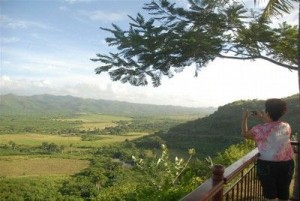 El Mirador is a sort of you-must-see spot in southern Cuba to recognize the landscape values of the place. From la Loma del Puerto, the Valley of the Sugar Mills wears its Cultural Heritage of Humanity lineage, given by UNESCO in 1988.
El Mirador is a sort of you-must-see spot in southern Cuba to recognize the landscape values of the place. From la Loma del Puerto, the Valley of the Sugar Mills wears its Cultural Heritage of Humanity lineage, given by UNESCO in 1988.
Of unquestionable heritage and landscape values, the valley benefits since 2009 of a development and full recovery program, led by the Ministry of Tourism (MINTUR) which includes more than a dozen institutions and sectors, such as Agriculture and Housing, the National Enterprise for Flora and Wildlife Protection, and the Curator’s Office of the southern Cuban City of Trinidad.
The top leadership of the country and experts in various fields appreciate its enormous potential as a unique tourist product, amid the urgency of Cuba to increase the uptake of fresh currency, which would support in a future certain socio-economic projects and programs.
According to Reiner Rendon Fernandez, MINTUR delegate in Sancti Spiritus, several actions are boosted in the Valley of the Sugar Mills. However, despite advances, the rhythm still does not correspond to the expectations of the actors involved in the general restoration of Trinidad’s vast plain.
What stage is the recovery process of the home-farms currently in?
Our ministry is responsible for five home-farms, this process includes the completion of projects, an adequate conceptualization and their use value. Next year we will start the rehabilitation of Buenavista’s and Guachinango’s, and in 2014 we intend to start with the rest.
The Curator’s Office is making significant actions in Guaimaro’s. In San Isidro, currently visited by tourists, works are being done in the bell tower. Flora and Fauna will start in two … With the recovery of these home-farms we will have almost 20 rooms within the valley.
But accomodations are not one of the fundamental purposes of the amelioration program.
No, they are not. The valley will have an extrahotel vocation. There will be a very large development of rural and community tourism. We seek to maximize the excursions and hiking in the same valley, taking into account the settlements there, their traditions, their sociocultural characteristics …
What actions are planned to improve the roofs of the houses, which, indeed, become inharmonious in that natural and heritage scenario?
As you say, those covers or roofs clash with the place, many of them are zinc-made. The purpose is to replace them with roof tiles or other similar alternatives. We already have the funds to do so, and next year over 200 roofs are to be replaced.
How much progress has been made in restoring the plantations of sugar cane and other crops, which distinguished the valley?
Logically, the restoration of the agricultural activity is a priority, which involves the sectors of Agriculture, Flora and Fauna… Some cane and other crops have been planted, some dozens of hectares of marabou have been cleared, but we need to continue reforesting. This isn’t a one-day task.
Of course, all investments, all that is made must be seen from an economic standpoint. What criteria are being used in this regard?
The valley has to be sustainable from the economic and heritage point of views, meaning that when we add up income and economic management of all stakeholders, profitability is reached. Of those profits we will obtain also the funding for further development of the valley, to continue preserving it.
 Escambray ENGLISH EDITION
Escambray ENGLISH EDITION






Escambray reserves the right to publish comments.